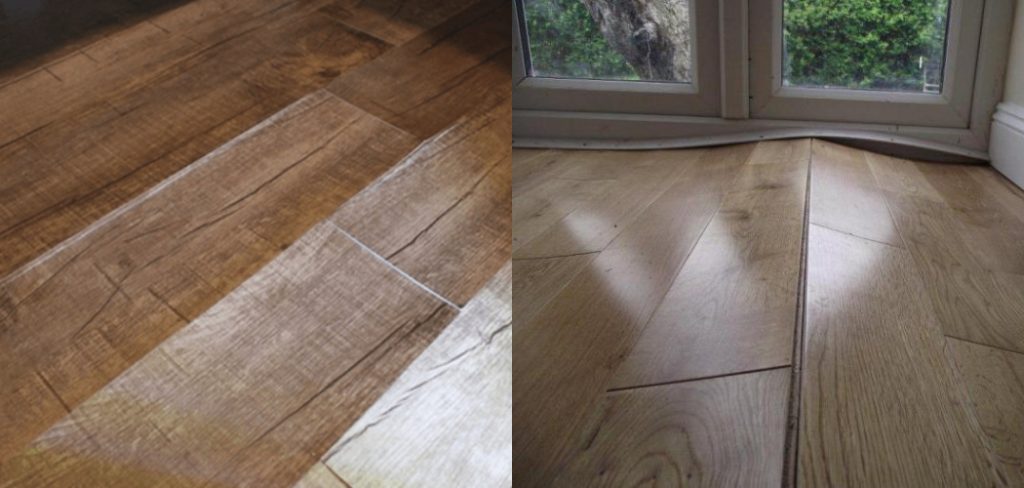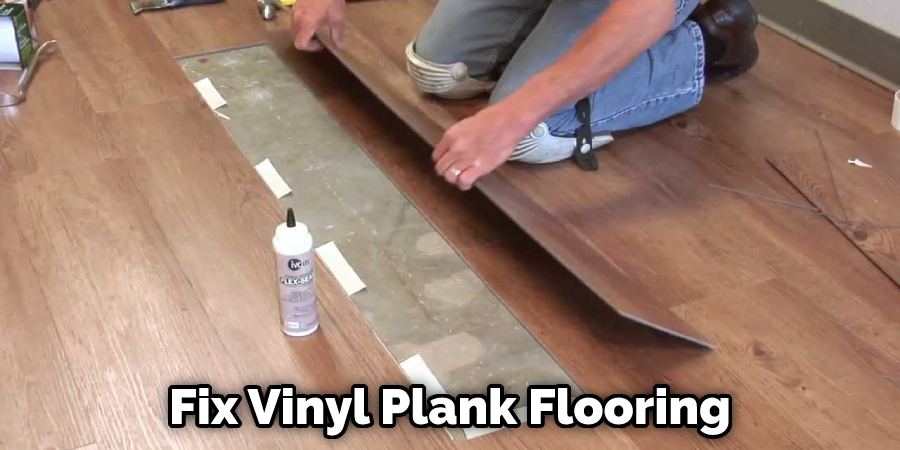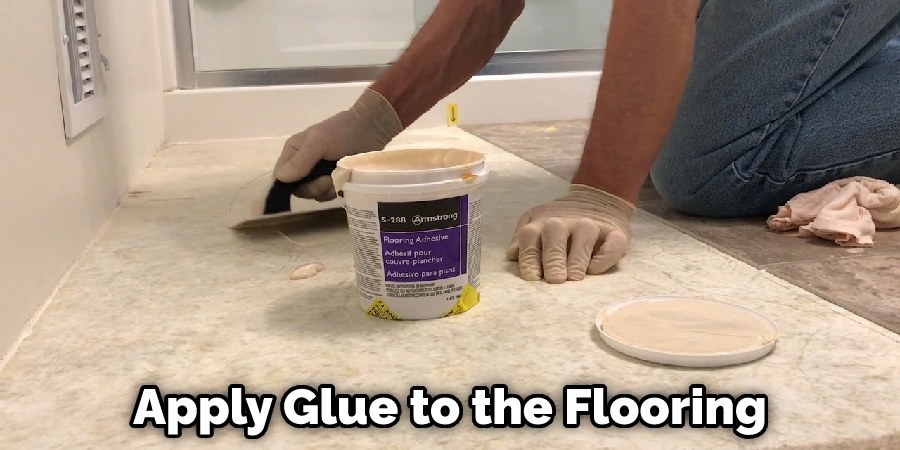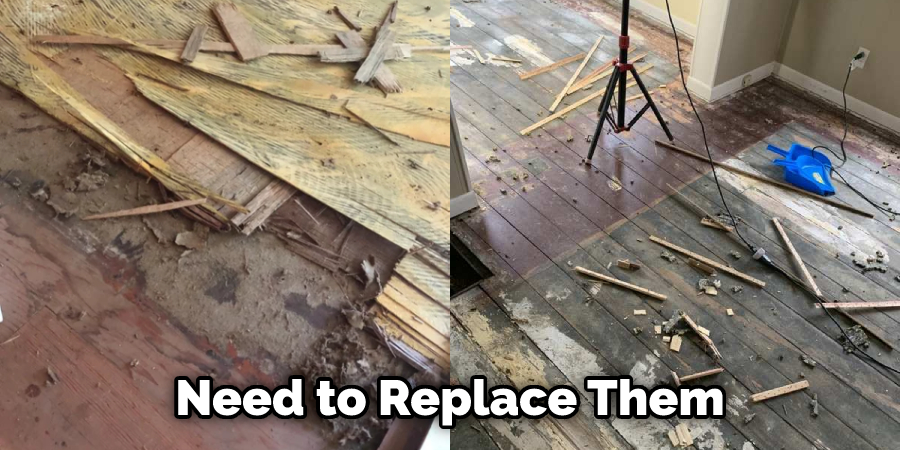Vinyl plank flooring is a popular flooring choice because it is affordable and durable. However, if your vinyl plank flooring starts to lift, it can be a major nuisance. This blog post will show you how to fix vinyl plank flooring that is lifting. Follow these simple steps, and your vinyl plank flooring will be good as new. Keep reading to learn more.

Summary: If you have vinyl plank flooring that is lifting, this can be a sign that the planks were not correctly installed. To fix it, make sure all of the seams are properly sealed and try to patch or replace any damaged planks. You will also need to clean the area thoroughly before installation and ensure that the floor has no hidden moisture issues.
What Causes Vinyl Plank Flooring to Lift?
There are several reasons why vinyl plank flooring may start to lift. The most common reason is moisture. If your vinyl plank flooring is exposed to moisture, it can cause the adhesive strips to loosen. This will cause the vinyl plank flooring to lift. Another common reason for lifting is dirt and debris. If your vinyl plank flooring is not properly cleaned, dirt and debris can build up on the adhesive strips.
This will also cause the vinyl plank flooring to lift. Another common reason for lifting is expansion and contraction. Vinyl plank flooring is susceptible to expansion and contraction due to temperature changes. If your vinyl plank flooring is installed in an area with extreme temperatures, it can cause the flooring to lift.
Lastly, improper installation can also cause vinyl plank flooring to lift. If your vinyl plank flooring is not installed correctly, it will not adhere properly and will start to lift.
Why Is It Important to Fix Vinyl Plank Flooring That Is Lifting?
It is important to fix vinyl plank flooring that is lifting for two reasons. First, lifting vinyl plank flooring can be a tripping hazard. If someone trips on a loose plank of vinyl flooring, they could seriously injure themselves. Second, lifting vinyl plank flooring can damage the flooring. If the vinyl plank flooring is not properly adhered to the floor, it can start to peel and tear.
This can damage the flooring and make it more difficult to clean. Another reason why it is important to fix vinyl plank flooring that is lifting is that it can cause gaps in the floor. If the vinyl plank flooring is not properly adhered to, gaps can form between the planks.
These gaps can collect dirt and debris, which can be difficult to clean. Lastly, lifting vinyl plank flooring can allow moisture to get under the flooring. This can cause mold and mildew to grow, which can be a health hazard.
Step by Step How to Fix Vinyl Plank Flooring That is Lifting
1. Clean the Floor

The first step to fixing vinyl plank flooring that is lifting is to clean the floor. This will remove any dirt and debris that may be causing the flooring to lift. You can use a vacuum cleaner or a mop to clean the floor. First, remove any loose dirt and debris from the floor. Then, vacuum the floor to remove any remaining dirt and debris. Finally, mop the floor with a mild soap and water solution. Make sure to get in all the corners and crevices.
2. Remove Moisture
If moisture is causing your vinyl plank flooring to lift, you will need to remove the moisture. The best way to do this is to use a dehumidifier. Place the dehumidifier in the room with the vinyl plank flooring and turn it on. Let the dehumidifier run until the floor is dry. You can also use a fan to help dry the floor. If you do not have a dehumidifier, you can open the windows and doors to let in the fresh air.
3. Use Painters Tape
If dirt and debris are causing your vinyl plank flooring to lift, you can use painter’s tape to secure the flooring. Painters tape is a gentle adhesive that will not damage your flooring. First, clean the area around the lifted vinyl plank. Then, apply the painter’s tape to the flooring and press down firmly. Allow the tape to sit for a few hours before removing it. If the vinyl plank is still lifting, you can repeat this process until the problem is resolved.
4. Apply Glue
If your vinyl plank flooring is lifting due to expansion and contraction, you can apply glue to the flooring. This will help to secure the flooring and prevent it from lifting further. You will need to use a construction adhesive or contact cement for this repair. Apply the glue to the flooring, and then use a roller to spread it evenly. Allow the glue to dry for 24 hours before walking on the flooring.

5. Use a Weighted Object
If your vinyl plank flooring is lifting due to expansion and contraction, you can use a weighted object to help secure the flooring. Place the weighted object on top of the lifted vinyl plank. The object’s weight will help keep the vinyl plank in place. You can use a heavy book, a stack of magazines, or a can of food. First, clean the area around the lifted vinyl plank. Then, place the weighted object on top of the plank and allow it to sit for 24 hours.
6. Heat the Flooring
If your vinyl plank flooring is lifting due to cold temperatures, you can try heating the flooring. This will help to expand the flooring and secure it in place. You can use a hair dryer, a heat gun, or a space heater for this repair. First, make sure that the area is well-ventilated.
Then, hold the heat source about six inches away from the flooring and move it around until the flooring is warm to the touch. You may need to do this several times to keep the vinyl plank flooring in place. You can use a fan to help cool the flooring down after you have heated it.
7. Use Nails
If your vinyl plank flooring is lifting due to expansion and contraction, you can use nails to help secure the flooring. First, identify the areas where the flooring is lifting. Then, use a hammer to drive nails into the flooring at an angle. Be sure to countersink the nails so that they are flush with the surface of the vinyl plank flooring.
You may need to use a nail set to ensure that the nails are properly countersunk. Once the nails are in place, you can use a putty knife to apply a small amount of adhesive under the lifted areas. Allow the adhesive to dry completely before walking on the floor.

8. Use Soap and Water
You can clean the flooring with soap and water if your vinyl plank flooring is lifting due to dirt and debris. First, sweep the floor to remove any loose dirt and debris. Then, mix a solution of mild dish soap and water. Use a damp mop to clean the floor, being sure to avoid saturating the floor. Rinse the floor with clean water and dry it with a towel.
9. Use a Clamp
If your vinyl plank flooring is lifting at the seams, you can use a clamp to help secure it back down. First, line up the two pieces of flooring that you want to clamp together. Then, position the clamp to hold the two flooring pieces together tightly. Finally, use a screwdriver or another tool to tighten the clamp until it is secure. This should help to hold the vinyl plank flooring in place and prevent it from lifting.
10. Use Caulk
Caulk can be used to fill in gaps and cracks in the vinyl plank flooring. This will help to secure the flooring and prevent it from lifting further. Apply the caulk around the room’s perimeter, as well as any cracks or gaps in the flooring itself. Smooth it out with a putty knife and allow it to dry completely before walking on the floor.
11. Replacing the Damaged Board
If some of your vinyl boards are completely damaged, you’ll need to replace them. First, remove the damaged board by prying it up with a putty knife. Then, measure the space where the board was and cut a new board to fit. Place the new board in the space and secure it with nails or adhesive. Allow the adhesive to dry completely before walking on the floor.

Tips and Warnings on How to Fix Vinyl Plank Flooring That is Lifting
Tips:
- Be sure to clean the area around the lifting vinyl plank before attempting any repairs.
- If the Vinyl Plank is loose in only one corner, try using a putty knife or other sharp object to push the vinyl back into place.
- If the entire plank is lifted, you may need to remove and replace it. First, use a utility knife to score around the perimeter of the lifted plank. Then, use a putty knife or other blunt object to pry the plank up.
- To install the new plank, apply adhesive to the subfloor and place the plank in position. Use a weight or other heavy object to hold the plank in place while the adhesive dries.
- If the corners of the plank are lifting, you can use a small amount of adhesive to secure them.
Warnings:
- Do not use too much adhesive, as this can cause the vinyl to buckle.
- Be careful when using a utility knife or other sharp object around the vinyl plank. You don’t want to damage the plank or hurt yourself.
- Make sure the adhesive you use is compatible with vinyl flooring. Consult a hardware store employee or the vinyl plank manufacturer for more information.
Frequently Asked Questions
What to Do if Vinyl Plank Floor is Lifting?
If you are noticing that your vinyl plank floor is lifting up, there are a few things that you can do to correct the issue. The first step is to check for cracks in the foundation or top layer of the flooring. If these appear to be the source of the problem, then it may be necessary to replace the entire floor. However, if just a section of your floor appears to be lifting up, you may only need to apply pressure down on that area with weights or duct tape in order not to cause further damage and fix it permanently with plywood subflooring or moldings.
Why is My Vinyl Plank Flooring Popping Up?
Vinyl plank flooring is a popular choice for many homeowners because it’s easy to keep clean, it’s durable, and it’s relatively affordable. However, vinyl plank flooring can also be prone to popping up – especially if the flooring is not properly installed or maintained. Here are some possible causes and solutions:
- Installation errors – When vinyl plank flooring is installed, there may be mistakes that lead to the plank flooring popping up. This can include incorrect nailing or screwing of the plank flooring, or improper installation techniques such as troweling while the flooring is still wet.
- Moisture damage – If the flooring is installed in a humid environment, it may become damaged and prone to popping up. This can happen due to condensation on the surface of the plank flooring, which causes it to expand and contract repeatedly.
- Poor maintenance – Poor maintenance can also lead to vinyl plank flooring popping up. This includes not cleaning the surface of the plank flooring regularly enough, not repairing tears or damages in a timely manner, or using inappropriate products or techniques when cleaning the flooring.
Can You Fix Vinyl Plank Flooring Separating?
Vinyl plank flooring is a popular option for homes and businesses because it’s easy to clean, durable, and affordable. However, separating vinyl plank flooring can be a challenge if the seams are not properly sealed.
There are several methods that you can use to seal the seams between vinyl planks including using adhesive or nails. The adhesive may be preferable since it will form a lasting bond between the planks and is less likely to cause damage over time. But either method should only be used if separate sealing is absolutely necessary due to moisture penetration or other issues with water retention.
What Causes Vinyl to Lift?
Vinyl plank flooring is a popular option for homes and businesses because it’s easy to clean, durable, and affordable. However, separating vinyl plank flooring can be a challenge if the seams are not properly sealed.
There are several methods that you can use to seal the seams between vinyl planks including using adhesive or nails. The adhesive may be preferable since it will form a lasting bond between the planks and is less likely to cause damage over time. But either method should only be used if separate sealing is absolutely necessary due to moisture penetration or other issues with water retention.
Conclusion
So there you have it! Those are some tips on how to fix vinyl plank flooring that is lifting. Be sure to follow the instructions carefully and take your time so that you don’t damage the flooring. With a little bit of effort, you should be able to get your vinyl plank flooring looking new again in no time. Thanks for reading!
